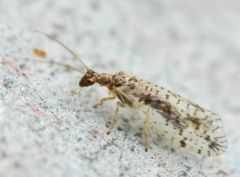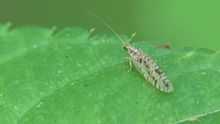Hemerobiidae
- "Hemerobioidea" redirects here. Numerous lacewing families were formerly included there but now are placed elsewhere; see text for details.
| Brown lacewings Temporal range: Jurassic–Recent | |
|---|---|
 | |
| Micromus variegatus adult (Microminae) | |
| Scientific classification | |
| Kingdom: | Animalia |
| Phylum: | Arthropoda |
| Class: | Insecta |
| Order: | Neuroptera |
| Suborder: | Hemerobiiformia |
| Superfamily: | Hemerobioidea |
| Family: | Hemerobiidae Latreille, 1802 |
| Subfamilies | |
|
10, see text | |
| Synonyms | |
|
Promegalomidae | |
Hemerobiidae is a family of Neuropteran insects commonly known as brown lacewings. These insects differ from the somewhat similar Chrysopidae (green lacewings) not only by the usual colouring but by the wing venation: hemerobiids having numerous long veins lacking in chrysopids. Some of the costal cross veins are forked, unlike in green lacewings. Imagines of subfamily Drepanepteryginae mimic dead leaves. Hemerobiid larvae are usually less hairy than chrysopid larvae.
Hemerobiids, like chrysopids, are predatory, especially on aphids, both as larvae and adults. The species Micromus tasmaniae is bred for biological pest control.[1]
Systematics
Despite their superficial similarity to chrysopids, the brown and green lacewings are not as closely related as was at one time believed. Rather, the Hemerobiidae are closely related to the dustywings and spongillaflies, as well as to the large superfamily Mantispoidea.
The superfamily Hemerobioidea is nowadays restricted to the Hemerobiidae. Formerly, the pleasing lacewings (Dilaridae), silky lacewings (Psychopsidae), giant lacewings (Polystoechotidae) and as noted above the green lacewings (Chrysopidae) were placed therein too. Of these, only the first seem to be reasonably close relatives of the brown lacewings. The silky lacewings in fact seem to belong to an altogether different suborder of Neuroptera, the Myrmeleontiformia.
The subfamilies of Hemerobiidae are:


|
|
Apart from the genera assigned to subfamilies, the genus Notherobius is of uncertain or fairly basal position.
Fossils
Numerous fossil Hemerobiidae have been described, some from the still-living genera, others from genera that are entirely extinct today. While most have been found in Eocene to Miocene rocks or amber, Promegalomus is known from the Jurassic. It was formerly considered to constitute a distinct family Promegalomidae, but is nowadays recognized as a very basal member of the Hemerobiidae. The Cretaceous Mesohemerobius was formerly considered a brown lacewing, but is today rather placed as incertae sedis in the Neuroptera; it might be a member of the Hemerobioidea but not even that is certain. Notable fossil Hemerobiidae genera are:[2]
- Bothromicromus Scudder, 1878 (Eocene/Oligocene; Quesnel, British Columbia)
- Brasilopsychopsis (Cretaceous, Crato Formation Brazil)
- Cratopsychopsis (Cretaceous, Crato Formation Brazil)
- Cretomerobius Ponomarenko, 1992 (Cretaceous to Ecoene; Bon-Tsagan, Mongolia; Klondike Mountain Formation, Washington)
- Mucropalpus Pictet, 1856 (Eocene; Baltic amber)
- Prochlanius Kruger, 1923 (Eocene; Baltic amber)
- Promegalomus Panfilov, 1980 (Jurassic; Chimkent Oblast, Kazakhstan)
- Prophlebonema Kruger, 1923 (Eocene; Baltic amber)
- Prospadobius Kruger, 1923 (Eocene; Baltic amber)
The extinct genus Hemerobites was originally described in 1813 from a specimen preserved in Baltic amber as a hemerobiid. However further study has resulted in its synonymy with the genus Eutermes and placement in the termite subfamily Termitina. The species Wesmaelius mathewesi, was described in 2003 from a solitary Eocene fossil found near Quesnel, British Columbia, and placed into the extant genus Wesmaelius. At that time it was the oldest Hemerobiinae species described.[3]
Some additional brown lacewing larvae have been found as fossils, but it has been impossible to determine their generic or subfamilial association.[2]
References
- ↑ New, TR (2002). "Prospects for extending the use of Australian lacewings in biological control" (PDF). Acta Zoologica Academiae Scientiarum Hungaricae. 48 (Supplement 2): 209–216.
- ↑ 2.0 2.1 Engel, MS; Grimaldi, DA (2007). "The neuropterid fauna of Dominican and Mexican amber (Neuropterida, Megaloptera, Neuroptera)" (PDF). American Museum Novitates 3587: 1–58.
- ↑ Makarkin, VN; Archibald, SB; Oswald, JD (2003). "New Early Eocene brown lacewings (Neuroptera: Hemerobiidae) from western North America". The Canadian Entomologist 135: 637 – 653.
- Chinery, Michael (1986): Collins Guide to the Insects of Britain and Western Europe.
External links
| Wikimedia Commons has media related to Hemerobiidae. |
- BioLib Taxonomic tree of Hemerobiidae (incomplete)
- Brown lacewings of Florida on the UF / IFAS Featured Creatures Web site
| ||||||||||||||||||||||||||||||||||||||||||||||||||||||||||||||||||||||||||||||||||||||||||||||||||||||||||||||||||||||||
| ||||||||||||||||||||||||||||||||||||||||||||||||||||||||||||||||
